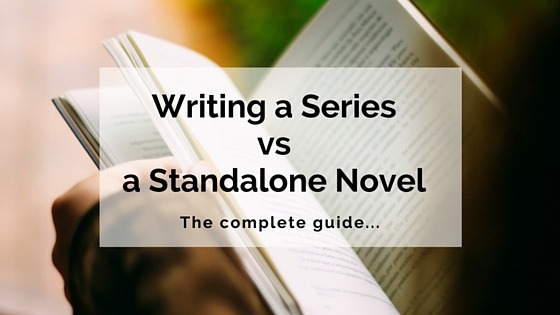A standalone novel and a series of novels are quite different forms to publish and write. Selling your novel is easier if you understand the unique marketing qualities of each, and how publishers handle and receive them differently.
Even before that stage, however, how do you decide in what form to write? In both publishing and writing there are different considerations for standalones and series novels that are handy for all authors to know. Before you pen your next piece or send off your finished manuscript, make sure to consider the following…

Table Of Contents
What’s the difference?
While standalones are always a single book, series can include anything from 2 to 200 instalments. A series follows the same story and characters throughout numerous books. Trilogies and series with an odd number of books are highly common.
For example, the 5 book series Percy Jackson & the Olympians by Rick Riordan, the 7 book series Narnia by C. S. Lewis and even the 45 book series Discworld by Terry Pratchett.
Duologies, otherwise known as a book with a sequel, have been a recent addition to series, and in the last few years have experienced a resurgence, particularly in YA. Often these are narrated by a different main character, such as a male and a female, as seen in Juliet Immortal and Romeo Redeemed by Stacey Jay.

Metanarratives
A metanarrative is an overarching story encompassing smaller ones. For the purpose of this article, it refers to a single storyline connecting multiple books. It can be tricky to balance an overarching plot as well as a novel-specific one. Fortunately, standalones don’t have this to consider, and neither do some series.
There are two types of series: serialised and formula. The former is when the first novel leads to the second novel, which then leads to third novel and so on. For example, Harry Potter and The Lord of the Rings fall into this category.
The latter is more common in children’s series and detective stories where the main characters or location appear in each novel, but each novel’s plot doesn’t rely on another’s. In fact, it’s much like a collection of standalones. Andy Griffiths’ The Treehouse Books and Agatha Christie’s Hercule Poirot are both formula series.
For formula series, metanarrative may only involve a gradual passing of time if at all, but it’s quite important for serialised series. It’s expected that at least some events in a serialised series novel are foreshadowed in the previous instalment and affect later sequels.
The Reign of the Genre
Genre has significant impact on how series or standalones are written and received. Series are often some form of fantasy, sci-fi, supernatural, dystopian genre stories. This has become an expectation amongst readers, and likely started due to the significant amount of world-building necessary for these genres. On the other hand, most contemporary, realistic and literary novels are standalone.
“One of the appealing aspects of genre fiction, both to readers and I’m sure publishers, is that most of it is series fiction. Very rarely in so-called ‘literary’ fiction do you find characters that recur in other novels.” — Jon Page
Perhaps as a writer you’ve unconsciously followed these trends, or maybe you’ve deliberately done so. Genre is an important consideration both when writing and getting published. If you haven’t done research into the series or standalone trends of your genre, it’s time to do some searching and pop into your local bookstore.
But what do you do if you really want to write a standalone fantasy, or a contemporary series?
It’s simple: love your story, write a good book and be persistent. In other words, do the same as you would to get any novel published, but be prepared to work even harder.
When looking for a publisher, your best bet is those that have already published a series or standalone in the same genre as yours. It’s good to get into the habit of taking note of who published a certain novel and checking their website.

Publishing Considerations
Which is easier to publish?
It may not seem so, but looking at Australian bookstores, there’s an approximate 1:1 ratio of standalones and books that are part of a series being published. Many believe that the market is flooded with series. This is in part because a few years ago it was flooded with series, and in part because it’s often cheaper and easier to market for series.
There was a time when it was actually easier to sell a trilogy than a stand-alone but today it’s probably even odds. Publishers are being more cautious, wanting to see how the first book performs before committing.” — Josh Adams, Literary Agent
A series behind an author’s back is a great way to get their name out. However, series are a high-risk, high-gain product. From a publisher’s perspective, if the first book in a series isn’t successful, they’re stuck with a contract for sequels that won’t sell.
One of the rising methods around this is for writers to submit a manuscript that can standalone or be extended into a series.
Why do publishers ask for series?
Sometimes writers submit a manuscript and a publisher accepts but wants a sequel or two. Wasn’t a contract series high-risk? Publishers have been around the industry long enough to know what is likely to sell and what isn’t.
If a manuscript is strong enough and aimed at the right audience to secure the sales of following novels, the publisher may choose to request this of the author.
Publishers are very select when it comes to asking for a series. Sales often diminish as a few readers lose interest in the story or get distracted after each new release. Series also don’t find new readers part-way through. They need to be hooked on the first book and carried through. Shona Martyn from HarperCollins shared that:
Book One always sells the most… If you keep 75% of your audience for Book 2 and another 75% of that audience for book 3 youʹve gone from 15,000 sales to 11,500 sales to 8437 sales. What the bookseller will see, is an author who can’t crack the magic 10,000 barrier and they may well lose interest in stocking future books.”
Series do however have the advantage of boosting backlist sales. When a sequel comes out, it can fuel extra sales to the previous books, bringing them “back to life”. This can also happen with standalones if you build a big name for yourself as an author. However, series can do this with a combination of your name as well as the characters’ names and the story itself.

Marketing benefits
Series help build an audience by making readers more familiar with the author’s name. This is important for marketing, as the author’s name is their brand.
Have you ever bought a book because you recalled reading another by the same author? Exactly. Publishing is a business, and while we like to think that it’s all about promoting literature and the arts, it’s also about making money.
If readers are hooked on the first novel of a series, they’re much more likely to pick up the next novel than another, unrelated one. This also helps the marketing team ride on the wave of the previous novel’s marketing. People are already looking out for the sequel and it doesn’t take as much marketing to trigger the memory of the previous novel than it would to draw attention to a completely new story.
Publishing standalones
Series have some marketing benefits, however, standalone novels can also be successful. Authors, such as John Green, have written enough successful standalones that their name is as well-known as some series writers. Building an audience to an author of standalones only requires a handful of great novels. Several great standalones can carry an author through their career better than an author who’s had one successful series.
To build up your author brand with standalones you need to consecutively write great novels – just as any series writer would need to. Readers can lose interest in a story that goes on for too long or has too big a gap between releases. However, this is only a concern for series.
Publishing bottom-line
More than anything, what’s important is the quality of the writing and the story. From the business perspective, a bad series won’t sell better than a few good standalones. If the first or second novel in a series is unpopular, the sales of the next are lost. But a standalone that doesn’t sell well is much less likely to affect the author’s next, unrelated novel sales.
Series do, however, have the advantage that a successful first novel supports the author’s next releases better than a good standalone.
Focus on making Book One the best it can possibly be. By all means ‘pitch’ the idea of subsequent books but expect a publisher to be wary. The more professionally you present Book One, the more likely a publisher will buy into the idea of Books Two, Three etc.”— Jeni Mawter

Choosing your form and writing it
What’s best for your story?
One of the most important considerations for every writer: does your story need a sequel?
Whilst you may enjoy writing a certain set of characters, you need to make sure you focus the story’s purpose. Writer Aly Hughes shares an interesting point on her blog:
One factor that can weigh in on this, is whether or not a book is character or plot driven… I tend to feel that character driven novels should be singular… However, with plot driven novels I’m more invested in the actual story and what happens.”
While characters may not drive the story in a series, they are important for drawing the reader in and pulling them into the sequel. It’s important to consider the subtle differences, between series and standalones, when choosing which is best for you and your story.
Can you and your story hold out?
To write a series, you need to be dedicated to the whole story, including all of the characters, the worlds, the plot, the voice, the mood and even tone.
Starting a series, getting bored a few books in and rushing the ending – or worse, leaving it hanging – isn’t going to leave a good impression on your readers or publisher. Make sure you know how to write and stay positive, and have the determination to maintain healthy writing habits.
Writing fatigue affects all writers and is caused by long periods of time with little rest. Many may spend most of their time, free from work and other commitments, writing. This results in writer’s block, poor quality prose and difficulty noticing mistakes.
To write a long piece of work such as a series requires good stamina, recognising when you need rest and acting on that.
Writing a series is like when a dinner guest becomes a roommate. Writing the first book is like having a dinner party with exciting and stimulating guests, carefully planned menu, atmosphere – but the guests get to go home. And you get to put your feet up and relax. Writing a series, the guests stay permanently. You have to think of exciting things for them to do, vary the menu, invite different guests for them to play with.” — Rebecca Forster
As well as your own commitment to the story, make sure it is able to keep moving and stay interesting across the significant number of extra pages a series can hold. Part of this includes knowing the characters and elements of your current story well enough to see the future story potential.
Flesh out a basic outline for a sequel or whole series, run your ideas past some other writing friends. If they agree that it sounds good, it’s time to get writing!

Which is best for your writing style?
Some writers produce series more naturally than standalones, or vice versa. There are some, of course, who are successful at writing both. However, finding which suits you more will help your natural talent flourish.
For example, if writing metanarrative’s isn’t your thing, or you’re often distracted by new ideas, aim for a standalone or formula series.
To discover which is best for your style, you must first explore and identify your own style. Look at the authors, genres and novels you love and examine their style. This includes everything from sentence length, word and syntax to the tone and mood. Is it poetic, analytical, humorous? Now look at your writing. Do you notice any similarity? It’s also useful to ask a few writing friends to try identify your style.
When it comes to fiction, writing style is often personal. Your own mind – and your own sense of balance – will dictate how you put a piece of writing together.” — Rob Parnell
Once you know your style, find stories written in a similar style and see how many are standalones and how many are series. From there, you should have a good indication of which is best for your writing. If the results differ from what you want to write, that’s okay too.

Some common pitfalls of series
Slow pacing makes for a dull read
Readers often complain that a series could’ve been written in a single volume. Slow pacing is often the issue.
The first way to fix this is to address whether or not the story would work better as a standalone, or as a shorter series. After that, brainstorm more ideas. If you find that you tend to stretch your plots out, consider writing plot outlines for several books and then trying to condense from there.
Slow pacing can be caused by poor writing, at a sentence level and at a higher level. Short sentences and action scenes should balance the long sentences and slower description or introspection scenes. On the higher-level, subplots pushing aside the main plot can also cause the impression of slow-pacing. Readers become frustrated when the main plot they’ve eagerly followed is forgotten for too long.
More than any other book, the second instalment in a trilogy suffers from slow pacing. This happens by focusing too much on the metanarrative and forgetting that individual books need full plots. To help learn how to write good “middle” books, enjoy the great books that have avoided this second-book slump.
Craft a balanced and pothole-free plot
Many series suffer a number of common issues. Let’s look at one well-known series that avoids them: J. K. Rowling’s Harry Potter. The thing to keep an eye on is balancing metanarrative and the individual book narrative. It’s not an easy task and often one is over-looked in favour of the other.
Harry Potter has a clear metanarrative (Harry defeating Voldemort), and also separate plots for each individual book (such as finding the philosopher’s stone). Mistakes in this often leads to the second issue, which is plot holes or inconsistencies.
Focusing more on the larger or smaller narrative can cause the smaller plots to have illogical, improbable or unexplained happenings that interfere with a smooth reading experience. That being said, it’s almost impossible to have no errors. Fans of Harry Potter have identified several within the series, but typically these are copy or word errors rather than structural or plot errors.
Another common plot issue with series is repeated plots. Each book in a series needs its own unique plot to avoid being repetitive and losing your reader. Again, J. K. Rowling has written her series without falling into this pitfall. Each book, while similar, deal with slightly different themes and very different plot structures and plot points. The final book isn’t even set in Hogwarts.
Writing a series means that every instalment must be as good as or better than the last. No rehashing of a theme. No cookie cutter plots. No formulas.” — Joe Moore
These plot issues can often be solved by planning everything in advance, with notes in separate columns (or some other form of distinction) for the metanarrative and individual novel narratives. Editor Beth Hill has written up a useful and comprehensive article about what to consider when planning both narratives.
Editor Beth Hill’s comprehensive article provides an detailed tips on the preparation and best practices for writing a series.

Avoid the over-detailed settings
Though a rich setting is desirable, there remains a limit. Just because you’ve got extra pages and volumes to fill, it doesn’t mean you need to go into excessive detail about your fictional world. This can actually be a common mistake, regardless of whether you’re writing a series or not. However, it can be more likely to slip through if you feel that you’ve plenty of room.
Many series are of a genre that require significant world-building, such as fantasy. The need for world-building is one of the things that leads to this pitfall.
While it’s important, as the writer, to know as much as you can about your world, readers don’t need to be as familiar with it. Description is important. However, keep it to the necessary and leave the rest of your pages for the story.
Some common pitfalls of standalones
Superficial characters
Character introduction, character development and the character arc can fall to the wayside when focusing on the plot. This doesn’t mean you should sacrifice a well-developed plot. Both plot and character development are important. But many popular standalones such as The Perks of Being a Wallflower by Stephen Chbosky, Looking for Alaska by John Green, and (I am) The Messenger by Markus Zusak are driven by characters, so be sure to put a bit of extra effort into knowing your characters.
While a series permits a writer to develop a set of characters over a period of time, a standalone novel represents the only opportunity these people have to live and breathe and tell their stories.” — Lise McClendon
A big trap that can lead to superficial characters are stereotypes. How do you avoid stereotypes?
The first way is to know what they are, which is sometimes universal and sometimes specific to genre. Avoiding stereotypes will bring depth to your characters. Once you understand what the most common stereotypes are, you can deliberately play on them by introducing a character in a stereotypical way but revealing their depth throughout the story.

“White room” syndrome
The same way many series often flood their fictional worlds with too much description, standalones can forget to add adequate description. This is known as “white room” syndrome. For all your readers know, your characters are doing and saying things while standing in a plain, white room. The right setting adds nuances to your character and plot that you don’t want to miss out on.
Some writers find it easier to focus on their natural strengths, such as characters and plot, in their first draft, and on the second draft work on description. While it’s good to know what your setting is before you write, don’t let your weaknesses take your attention away from your strengths. When adding description, be sure to remember all five senses.
Loose story, loose writing
If your imagination is active and regularly goes on tangents that lead to more subplots and twists and turns, you’ll need to rein it in if you want to stick to a standalone. Keep it short and sweet. While some standalones have successfully led the way to a series, it’s better if series potential is written into a novel from the start.
Standalones have fewer pages to work a story than a series. This means your writing needs to get to the point, but still be full of rich description, heart-racing plot and loveable characters. Writing in this way may come naturally to you, or may require practice and a few useful writing tips to get you heading in the right direction.

The market exists for great stories, whether in standalone or series form. As long as you recognise the unique traits of the form you chose and write with them in mind, you can make your story successful.
3 responses to “The Essential Guide for Writing a Series vs. a Standalone Novel”
Great article and it has a lot of useful tips. I am working on a story idea now and I am trying to decide between making it a standalone novel or series. I like your idea on researching books in your genre and see if they are standalone or series. I will do some research today on it. But, its a difficult decision, my story is a more realistic based tech thriller, but I am attracted to the series idea.
Thanks for stopping by Loren! We’re glad you found the article useful. It’s definitely worth researching within your genre and seeing what fellow authors are doing, but equally as important is making sure your narrative has enough plot for multiple books!
Let us know how you go 🙂
We wish you all the best with your writing.
– The Writer’s Edit Team
I’ve wondered about marketing a series. So many articles tell you that the best way to get your name out there is to write many books, but they fail to discuss whether these books are in a series or a standalone. This article clears up some of my questions. I’m working on a six book series, but I’m starting to think that it might help if I also published a standalone or two, maybe even taking a break from the series, to reach more new readers.